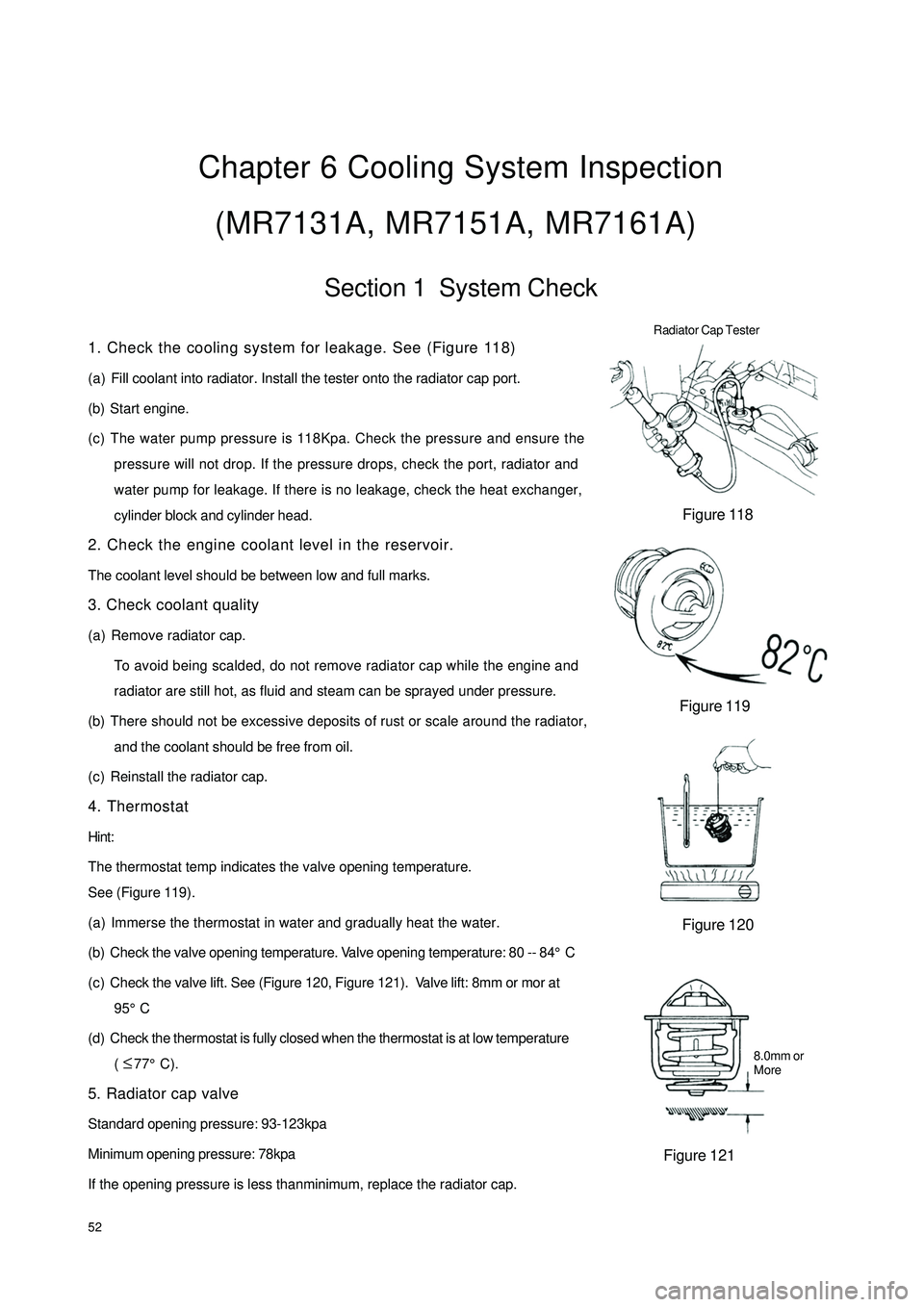CD changer GEELY CK 2008 Workshop Manual
[x] Cancel search | Manufacturer: GEELY, Model Year: 2008, Model line: CK, Model: GEELY CK 2008Pages: 392, PDF Size: 38.86 MB
Page 59 of 392

52Chapter 6 Cooling System Inspection
(MR7131A, MR7151A, MR7161A)Section 1 System Check1. Check the cooling system for leakage. See (Figure 118)
(a) Fill coolant into radiator. Install the tester onto the radiator cap port.
(b) Start engine.
(c) The water pump pressure is 118Kpa. Check the pressure and ensure the
pressure will not drop. If the pressure drops, check the port, radiator and
water pump for leakage. If there is no leakage, check the heat exchanger,
cylinder block and cylinder head.
2. Check the engine coolant level in the reservoir.
The coolant level should be between low and full marks.
3. Check coolant quality
(a) Remove radiator cap.
To avoid being scalded, do not remove radiator cap while the engine and
radiator are still hot, as fluid and steam can be sprayed under pressure.
(b) There should not be excessive deposits of rust or scale around the radiator,
and the coolant should be free from oil.
(c) Reinstall the radiator cap.
4. Thermostat
Hint:
The thermostat temp indicates the valve opening temperature.
See (Figure 119).
(a) Immerse the thermostat in water and gradually heat the water.
(b) Check the valve opening temperature. Valve opening temperature: 80 -- 84°C
(c) Check the valve lift. See (Figure 120, Figure 121). Valve lift: 8mm or mor at
95°C
(d) Check the thermostat is fully closed when the thermostat is at low temperature
( 77°C).
5. Radiator cap valve
Standard opening pressure: 93-123kpa
Minimum opening pressure: 78kpa
If the opening pressure is less thanminimum, replace the radiator cap.Figure 118
Figure 119
Figure 120
Figure 121 Radiator Cap Tester8.0mm or
More ≤
Page 304 of 392

297Part IV Air Conditioner and Inside &
Outside TrimChapter 1 A/C SystemA/C system consists of refrigerating and heating system. The Refrigeration system mainly comprises
compressor, condenser and evaporator. The refrigerant circulation absorbs the heat in the air and discharge
the vapour to lower the temperature in and dehumidify the compartment. The heating system is mainly
composed of heat exchanger and heater. It heats the compartment throught the heat exchanger by heating
the air with the heat from the cooling water in the engine. The control of air temperature, humidity and
velocity of flow in the compartment is realized by independent or joint working of heating and Refrigeration
system.Section 1 The Structure & Working Principle of Refrigeration SystemThe structure of Refrigeration system is shown in Figure 1.
Figure 1 The Structure and Working Principle of Refrigeration System
1. Compressor 2. Condenser 3.Receiver/Drier
4.Pressure Relief Valve 5.Expansion Valve 6.Evaporator 7.Blower
Refrigeration system uses vapor compressing refrigeration cycle, comprising the compressor, condenser,
pressure relief valve, evaporator, blower , expansion valve, receiver/drier and pipe.
It's working principle is as shown in the Figure 1. The compressor (1) sucks in the refrigerant gas in the
Page 308 of 392

301 4. Heater
Figure 5 Heater Door Control Diagram
The heater comprises the heater radiator (heat exchanger), the plastic case forming the air duct, connecting
rods adjusting different air ducts and the door. The two groups of combination doors in the heater case are
connected to the heating control mechanism by the cable. The first group is the two couple action doors
adjusting the air mix ratio that are located in the outlet and inlet each; the second group comprises 4 doors
controlling the air outlet vents, where the upper center one controls the front outlet vent, each of the upper
left and right sides controls a defogger outlet vent and lower foot outlet vent. Figure 5 shows the working
principle of temperature adjustment door. The d) , c) , e) , f) in the figure indicate the outlet air flow direction
as the result of the adjustment of the control knob in the heating control mechanism panel.Hot Wind LocationCold Wind LocationLinkageRadiator CoreRadiator CoreTemperature Adjustment
Door Working PrincipleFoot OutletTo Front OutletTo DefrosterRadiator CoreTo Front OutletRadiator CoreFoot OutletFoot OutletTo Defroster